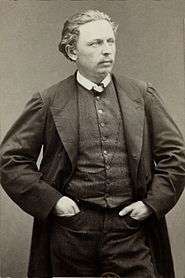Émile Breton
Émile Adélard Breton (8 March 1831, Courrières - 24 November 1902, Courrières) was a French painter and engraver; best known for his moody nocturnal landscapes with figures.

Biography
His older brother, Jules, was also a painter and gave him his first lessons, although he was largely self-taught. His younger brother, Ludovic Breton, was an engineer who was in charge of drilling for the first attempt to build a cross-channel railway tunnel.
His first exhibition was at the Salon in 1861. He later won a medal there three years in a row (1866–68) and was awarded a first-class medal at the Exposition Universelle (1878). Following that, he was named a Knight in the Legion of Honor.[1] He was given a gold medal at the Exposition Universelle (1889).
During the Franco-Prussian War, he served as a commander of the forces in Pas-de-Calais. He also served as Mayor of Courrières, as did his father, Marie-Louis Breton (1796–1848) and his uncle, Boniface Breton (1829–1891).
He was profoundly affected by the death of his only son, Louis, in 1891 at the age of twenty-nine, which came shortly after the death of his wife. The following year, he decided to abandon painting and sold his entire workshop at auction.[2] Later, he began painting again, but produced very little.
His niece was Virginie Demont-Breton, who was also a well-known painter. Adrien Demont (who married his niece) and Henri Duhem were among his best-known students. A street in Courrières has been named after him.
References
- Documentation @ the Base Léonore.
- Auction catalogue @ BNF Gallica.
External links
![]()
- ArtNet: More works by Breton.
- Paintings by Breton @ Musenor
- Letters by Vincent van Gogh that mention Breton.